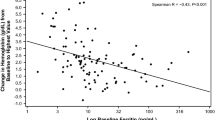Abstract
Iron-deficiency anemia (IDA) accounts for majority of anemia. Although iron replacement therapy is effective, in Japan, conventional iron formulations have disadvantages such as gastrointestinal side effects for oral formulations and issues of frequent administration for intravenous (IV) formulations. Ferric carboxymaltose (FCM), which overcomes these limitations, is widely used as an IV iron source overseas. In this multi-center, open-label, single-arm study, we investigated the safety and efficacy of FCM up to 12 weeks after the start of administration in patients with IDA caused by digestive diseases. Thirty-nine patients diagnosed with IDA based on hemoglobin and serum ferritin levels were included. Eligible subjects were administered FCM until the total calculated iron dose (1000 or 1500 mg) was achieved over intervals of at least 1 week. A single iron dose was 500 mg. In the full analysis set (n = 39), the incidence of adverse events and adverse drug reactions was 71.8 and 48.7%, respectively. All events were as expected from the safety profile of IV iron. The mean change from baseline (10.39 g/dL) to the highest observed hemoglobin level was 3.31 g/dL. These results indicate the safety and efficacy of FCM for treating IDA caused by digestive diseases in Japanese patients.



Similar content being viewed by others
References
World Health Organization. Iron deficiency anemia-assessment, prevention, and control. A guide for program managers. 2001. Report No.: Document WHO/NHD/01.3.
Harigae H. Iron metabolism and related diseases: an overview. Int J Hematol. 2018;107:5–6.
Adamson JW. Iron deficiency and other hypoproliferative anemias. In: Longo DL, Fauci AS, Kasper DL, Hauser SL, Jameson JL, Loscalzo J, editors. Harrison’s principles of internal medicine. 18th ed. New York: McGraw-Hill Companies; 2013. pp. 844–51.
Cada DJ, Levien TL, Baker DE. Ferric carboxymaltose. Hosp Pharm. 2014;49:52–69.
Ikuta K, Shimura A, Terauchi M, Yoshii K, Kawabata Y. Pharmacokinetics, pharmacodynamics, safety, and tolerability of intravenous ferric carboxymaltose: a dose-escalation study in Japanese volunteers with iron-deficiency anemia. Int J Hematol. 2018;107:519–27.
Ikuta K, Hanashi H, Hirai K, Ota Y, Matsuyama Y, Shimura A, Terauchi M, Momoeda M. Comparison of efficacy and safety between intravenous ferric carboxymaltose and saccharated ferric oxide in Japanese patients with iron-deficiency anemia due to hypermenorrhea: a multi-center, randomized, open-label noninferiority study. Int J Hematol. 2018. https://doi.org/10.1007/s12185-018-2501-8.
Kulnigg S, Stoinov S, Simanenkov V, Dudar LV, Karnafel W, Garcia LC, et al. A novel intravenous iron formulation for treatment of anemia in inflammatory bowel disease: the ferric carboxymaltose (FERINJECT) randomized controlled trial. Am J Gastroenterol. 2008;103:1182–92.
Evstatiev R, Marteau P, Iqbal T, Khalif IL, Stein J, Bokemeyer B, et al. FERGIcor, a randomized controlled trial on ferric carboxymaltose for iron deficiency anemia in inflammatory bowel disease. Gastroenterology. 2011;141:846–53.
Girelli D, Ugolini S, Busti F, Marchi G, Castagna A. Modern iron replacement therapy: clinical and pathophysiological insights. Int J Hematol. 2018;107:16–30.
Suzuki T, Ozawa K. Post-transfusion iron overload. J Jpn Soci Intern Medi. 2012;101:1986–93. (in Japanese).
Shenoy N, Vallumsetla N, Rachmilewitz E, Verma A, Ginzburg Y. Impact of iron overload and potential benefit from iron chelation in low-risk myelodysplastic syndrome. Blood. 2014;124:873–81.
Acknowledgements
The authors are grateful to the patients and their families for their contributions.
Author information
Authors and Affiliations
Corresponding author
Ethics declarations
Conflict of interest
The present study was performed as a Phase III study funded by Zeria Pharmaceutical Co., Ltd. Ito, Takahashi, and Suzuki received research funding from Zeria Pharmaceutical Co., Ltd. Ikuta received personal fees as a medical specialist from Zeria Pharmaceutical Co., Ltd. Masaki and Terauchi are employees of Zeria Pharmaceutical Co., Ltd.
About this article
Cite this article
Ikuta, K., Ito, H., Takahashi, K. et al. Safety and efficacy of intravenous ferric carboxymaltose in Japanese patients with iron-deficiency anemia caused by digestive diseases: an open-label, single-arm study. Int J Hematol 109, 50–58 (2019). https://doi.org/10.1007/s12185-018-2529-9
Received:
Revised:
Accepted:
Published:
Issue Date:
DOI: https://doi.org/10.1007/s12185-018-2529-9




